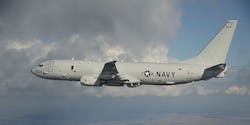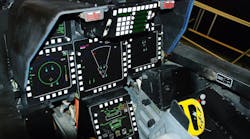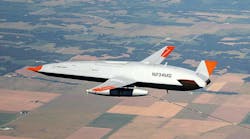Officials of the Naval Air Warfare Center Aircraft Division at Joint Base McGuire–Dix–Lakehurst, N.J., awarded a $9.6 million delivery order to Progeny Systems Wednesday for work on the Maritime Airborne Service Oriented Architecture Integration program.
This initiative seeks to develop a maritime airborne service oriented engineering development model of the increment 3 architecture of the Navy Boeing P-8A Poseidon -- a militarized version of the Boeing 727 passenger jet modified for maritime patrol and anti-submarine warfare.
Progeny's software model is necessary to support the P-8A network-ready and interoperability requirements, which include research and development for the source code and the Unified Modeling Language Model, Navy officials say.
The delivery order awarded Wednesday is part of a contract originally awarded to Progeny in September 2013 for Maritime Airborne Service Oriented Architecture Integration work involving the P-8 maritime patrol aircraft. The original deal was a Small Business Innovation Research (SBIR) Phase III contract.
The Maritime Airborne Service Oriented Architecture Integration program seeks to upgrade flight software to enhance network connectivity. Most of today's Navy aircraft are unable to adapt to rapidly changing network-centric requirements due to limitations in their traditional siloed software architectures.
Related: Boeing to provide Navy P-8A Poseidon patrol jet flight simulators in $225 million contract
This traditionally developed software often involve closed, proprietary systems and subsystems that require extensive, expensive, and time-consuming engineering and re-engineering to gain access to systems and sensor data.
The service-oriented architecture (SOA) software design approach encourages openness through standardization, and enables reuse and rapid integration of information, Navy officials say.
SOA software design helps engineers upgrade existing software, enable users to run it securely, and make the software adaptable for future change that will be simple, straightforward, safe, and fast, Navy officials say.
Software experts at Progeny Systems seek to use SOA design principles and practices to develop an open-architecture system that will integrate The P-8A's legacy airborne mission-computing systems and sensors so as to provide near-real time dissemination of collected maritime airborne mission data.
The goal is to lay a foundation for a common software-integration architecture for maritime aircraft like the P-8 Poseidon that quickly can establish network-centric qualities and enable the rapid insertion of emerging technologies more economically than is possible today.
On the delivery order announced this week, Progeny Systems will do the work in Manassas, Va., and should be finished by December 2015. For more information contact Progeny Systems online at www.progeny.net, or the Naval Air Warfare Center Aircraft Division-Lakehurst at www.navair.navy.mil.



